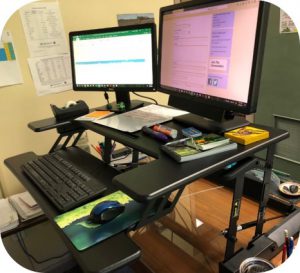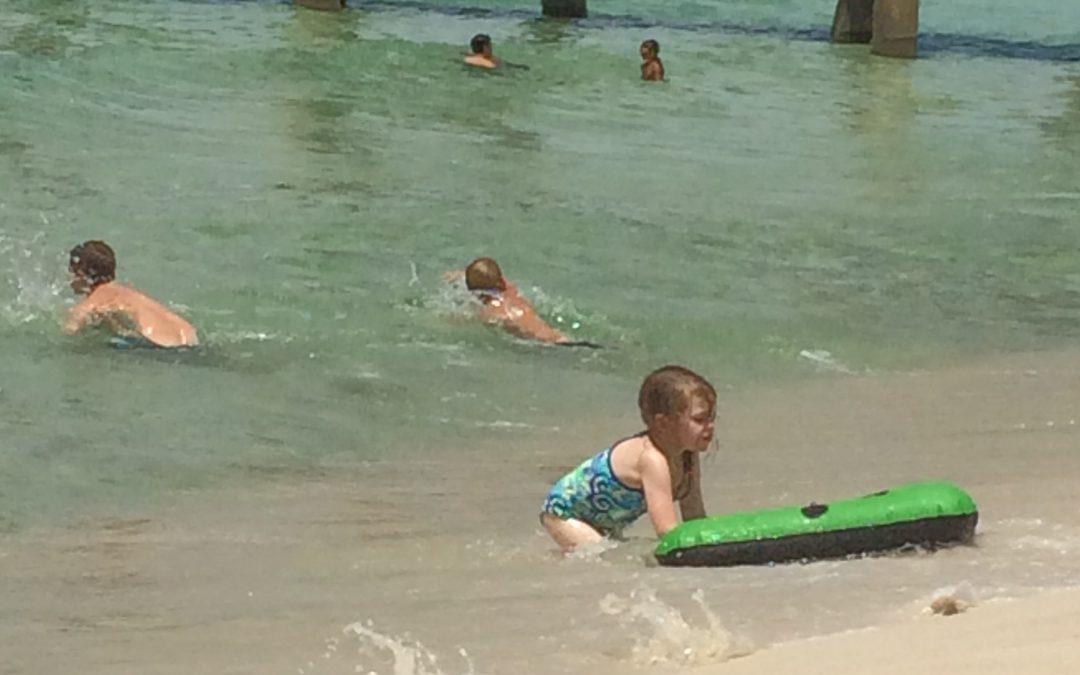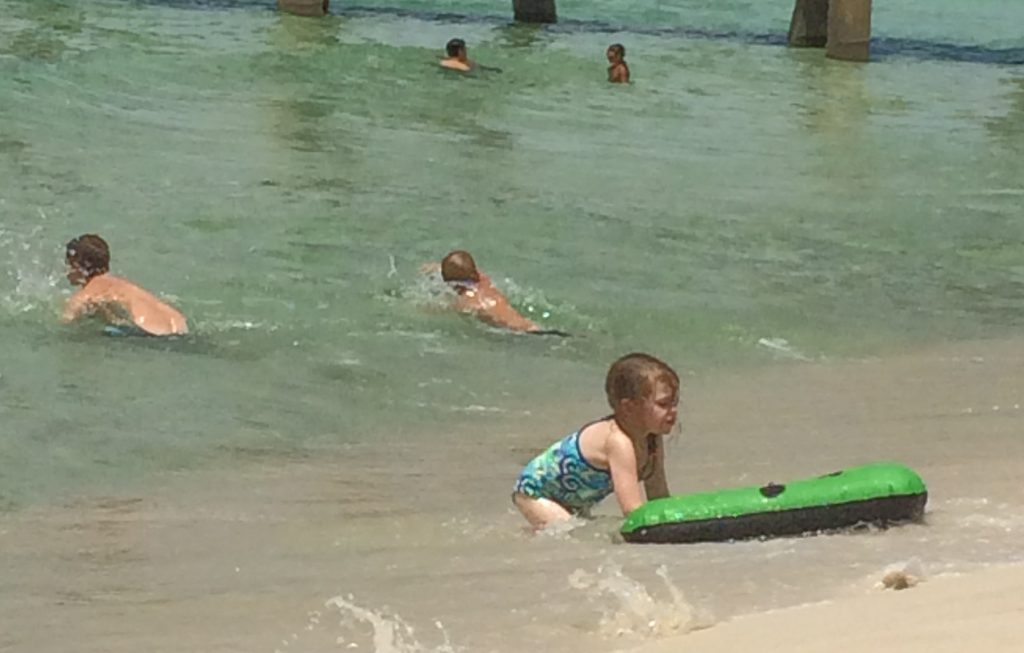
by Amy Mullins | Jul 26, 2018

Get out of your chair. Photo source: Amy Mullins
Have you ever thought about how many hours a day you spend sitting? Sitting at your desk, sitting in front of a computer, sitting watching television, sitting in the car, sitting, sitting, sitting. On average, Americans sit approximately 13 hours a day and sleep 8 hours adding up to a whopping 21 hours of inactivity. All of this sitting around may in fact be shortening our lives.
The cumulative effect of daily inactivity, or sedentary time, has contributed to a nationwide crisis of escalating chronic health conditions that include obesity, heart disease, high blood pressure, stroke, certain cancers, and type-2 diabetes. According to research, including a 2014 Harvard study of over 92,000 women, the risk of dying from stroke, heart disease, and cancer increases with the more time spent standing. In addition, the negative effects of excessive sitting seem to be just as strong in people that participated in a regular exercise regimen!
Standing Has Many Benefits
Our bodies increase a fat-burning enzyme called Lipoprotein Lipase when muscles are activated. This doesn’t just happen during purposeful exercise, but even during periods of standing. In fact, standing burns 30% more calories than sitting still! Regular engagement of muscles keeps them in a more continuous metabolic state that helps improve blood cholesterol, blood pressure, and blood sugar levels. Regular intervals of standing with minimal movement does all of this and so much more:
- Improves posture
- Tones muscles
- Increases blood flow
- Improves metabolism
- Improves mood
- Increases mental energy
- Reduces fatigue
During a typical day at work, experts recommend not sitting for more than 20 minutes at a time with regular intervals of standing. Standing up and walking even for just 5 minutes can lift your mood, increase mental energy and productivity, and can even dull your urge for unnecessary snacking.
What You Can Do

Standing desk. Photo source: Amy Mullins
Get up and move more! Consider some of these ideas to help in your quest to be more active during the day:
- Create a culture of health and encourage others in your workplace to support one another.
- Purchase a “standing desk” or get creative and make one to meet your needs
- Use a smartphone app, wrist monitoring device (such as a FitBit), or just an alarm on your phone or desktop to remind you to stand up and stretch or to walk outside for some fresh air.
- Instead of emailing or calling a co-worker, get up and take a stroll down the hall.
- On a conference call? Stand, move, stretch, do squats or desk push-ups.
- Take the stairs as often as you can.
- Forget hum-drum meetings in the conference room! Get creative on your feet and schedule walking meetings.
- Skip the afternoon coffee and energize with some office exercises. Consider getting an exercise mat, resistance band, stability ball and light weights.
- Wear comfortable shoes and clothing to the office and enjoy part of your lunch break taking a brisk walk and/or stretching.
- Bring your own reusable bottle to work and drink more water throughout the day. More water means more times you’ll have to walk to the restroom!
It’s not easy to create positive habits, but your health is worth it. But, making even a few changes to your normal routine can put you on a path to a happier and healthier life. For additional information about healthy habits in the workplace, visit:
NIH U.S. National Library of Medicine
U.S. Division of Occupational Health and Safety
CDC Workplace Health Promotion
University of Michigan Computer Ergonomics

by Melanie Taylor | Jun 23, 2018

Always supervise children closely around water.
Photo credit: Marie Arick
Summer is here! As the long, hot days of summer move forward there are many things to consider when it comes to children and water safety. Each summer we hear of tragic incidents of children drowning in pools, spas, and other bodies of water. These tragedies may be avoided by following a few simple tips to keep your child safe while letting them enjoy their summer break.
The U.S. Consumer Product Safety Commission (CPSC) is the agency charged with protecting the public from unreasonable risks of injury or death from thousands of types of consumer products under the agency’s jurisdiction. In addition to Pool and Spa Safety, the CPSC is committed to protecting consumers and families from products that pose a fire, electrical, chemical, or mechanical hazard. CPSC launched the campaign, PoolSafely.gov, which provides Pool Safely: Simple Steps to Save Lives, a national public education campaign to reduce childhood drownings, submersion injuries and entrapments. Review these tips below.
Tips from PoolSafely.gov and CPSC:
- Never leave a child unattended in or near water.
It is recommended to designate an official “Water Watcher”, this is an adult assigned with supervising the children in the water. This should be their only task – they should not be reading, texting or playing games on their phone. Have a phone close by at all times, in case you need to call for help, and if a child is missing, check the pool first. Even when a lifeguard is present, parents and caregivers should still take the responsibility of being a designated “Water Watcher”. When the lifeguard chair is empty, the other lifeguards may not be able to see the entire pool and when lifeguards are sitting in low chairs; other people in the pool can block their view.
- Teach children how to swim.
Swimming is fun, great exercise and it is a lifesaving skill, so why would you not instill this skill in your child? Be sure to enroll children in swimming lessons – the earlier the better. A few swimming lessons may just save their life.
- Teach children to stay away from pool drains.
Show your children where the pool drain is located and remind them of the dangers of those drains. Remind them not to play or swim near drains or suction outlets, especially in spas and shallow pools, and never enter a pool or spa that has a loose, broken or missing drain cover. Sadly, children’s hair, limbs, jewelry or bathing suits, etc. can get stuck in a drain or suction opening. When enjoying time in a spa, be sure to locate the emergency vacuum shutoff before getting in the water.
- Ensure all pools and spas – both in your backyard and any public pool you may visit – have compliant drain covers.
The powerful suction from a pool or spa drain can even trap an adult, let alone a child. The Pool and Spa Safety Act is named after Virginia Graeme Baker, a child that tragically died from drowning due to a suction entrapment from a faulty drain cover. Do to this act, it is now required by law that all public pools and spas must have drain grates or covers that meet safety standards to avoid incidents like the one that took Graeme’s life.
- Install proper barriers, covers and alarms on and around your pool and spa.
One of the biggest dangers with pools or spas is when they are left open without any proper fences, barriers, alarms and covers. Each of these can be lifesaving devices. A fence of at least four feet in height should surround the pool or spa on all sides and should not be made of a climbable material. The pool should only be accessible through a self-closing, self-latching gate. Teach children to never climb over a pool gate or fence. Always remove portable pool ladders when not in use, just so your child is not enticed to enter the water. It is also highly recommended to install a door alarm from the house to the pool area, and keep pool and spa covers in working order.
- Know how to perform CPR on children and adults.
CPR can be the reason a drowning victim survives. With all of the possible locations of CPR trainings, why not get CPR certified as an extra precaution in case there is a water emergency? CPR classes are available through many hospitals, community centers, or by contacting your local American Red Cross. Once certified, be sure to keep the certification up to date.
- Finally, take the Pledge!
Before heading to the water with your family, remember to take the Pool Safely Pledge. This online call to action is a reminder to stay safer around the water. This pledge for you and your child can be found at https://www.poolsafely.gov/pledge/. The pledge is supported by CPSC and the PoolSafely.gov initiative and Olympic swimmer Michael Phelp along with over 60,000 other pledge takers. Parents, you can also download coloring sheets and other fun PoolSafely.gov child friendly apps and songs.
With the large variety of water related summer activities available it does leave a chance for risky incidents. Some work and preparation ahead of time will make for a less anxious and more fun-filled summer. Planning for risk will lessen the high-risk stakes and make sure everyone is prepared in case of an emergency. So remember, Simple Steps Save Lives. Enjoy a safe, fun, and water filled time this summer!
Resources: For more information be sure to visit Pool Safely: Simple Steps Save Lives – https://www.poolsafely.gov

by Angela Hinkle | Oct 27, 2017

Favorite Fall Things
Photo Credit: Angela Hinkle
Fall is my favorite time of year. Let me share with you a few of my favorite Fall things to help explain why.
- Walking my dog in the heat of a summer morning is like trudging through a bowl of warm chowder. But with the cooler autumn mornings arriving, we become invigorated and feel like taking longer walks to add steps to the pedometer on my hip. Let’s hear it for more physical activity! For walking tips, check out cdc walking counts.
- Just think about all of those yummy, nutrient-dense foods available this time of year – peanuts, sweet potatoes, and squashes and gourds in a variety of shapes, colors, and sizes. See Florida Panhandle Produce in Season for seasonal produce in the Florida Panhandle.
- Okay, so leaves don’t really change color a whole lot when fall weather hits the panhandle of Florida. But I have this great tree outside my office window. My horticulture agent says it’s a Bald Cypress. This time of year, I get to see it change leaf colors from green, to golden yellow, to burnt orange. Simply beautiful. Look around your neighborhood to see what bounty of colors you can find.
- Though you will not find me wearing any shade of orange or deep yellow (those are definitely not in my color palette), I do cherish all the oranges, deep reds, purples, and yellows found in the flowers, pumpkins, scarecrows, and decorative corn stalks. Perk up your area with some fall color. Dollar stores have lots to pick and choose from.
- I’ve had my DNA tested. I am, in fact, 41% Sicilian. My holidays can therefore start with Columbus Day, work their way through the fun of Halloween, the respectful honors of Veteran’s Day, and through Thanksgiving with a myriad of Fall Harvest Celebrations sprinkled in between.
To get you in the Fall mood, try this simmering potpourri recipe. Let me know if you like it and be sure to share with family and friends some of your favorite fall things.
Favorite Fall Stovetop Potpourri
Add any or all of the following ingredients to a small pot: ground cinnamon, cinnamon sticks, orange peelings, ground ginger, whole cloves, ground cloves, vanilla extract, and almond extract. Add enough water to fill pot to rim. Then put the pot on the stove top at lowest setting. Add more water as necessary. Enjoy!
by Amy Mullins | Apr 3, 2017
 It’s no secret that exercise is good for you and can improve your life in so many ways. The idea of exercise can be daunting for some people, especially if you’ve never done it on a regular basis. You don’t have to go to the gym and lift weights or run a half -marathon to “exercise.” It’s important to keep in mind that many different types of physical activity can be considered exercise and can get you on the path to feeling great every day.
It’s no secret that exercise is good for you and can improve your life in so many ways. The idea of exercise can be daunting for some people, especially if you’ve never done it on a regular basis. You don’t have to go to the gym and lift weights or run a half -marathon to “exercise.” It’s important to keep in mind that many different types of physical activity can be considered exercise and can get you on the path to feeling great every day.
Benefits of physical activity include:
- Increasing your chances of living longer
- Feeling better about yourself
- Decreasing your chances of becoming depressed
- Sleeping well at night
- Moving around more easily
- Having stronger muscles and bones
- Achieving and maintaining a healthy weight
- Being with friends or meeting new people
- Enjoying yourself and having fun!
Consider some new ways to become active such as:
- Volunteering within your community
- Taking group walks around the neighborhood
- Taking up gardening and growing vegetables or flowers
- Doing stretches and chair exercises throughout the day and while watching TV or on the computer.
The idea is to find FUN activities that will keep you moving, active, and engaged. If you decide to start a more rigorous exercise regimen, make sure to ask your doctor first.
Always keep proper hydration in mind, especially when exercising outdoors during the summer heat. Dehydration is a leading cause of hospitalization and serious health problems for older adults. Signs and symptoms of dehydration include headaches, constipation, muscle cramps, dry mouth, sleepiness, and rapid heart rate. It’s important to hydrate yourself with at least eight 8-oz. cups of water during the day. Stay ahead of the game and don’t wait until you’re thirsty to drink… by then, you are already dehydrated.
The National Institutes of Health, National Institutes on Aging recommend making these five tips a priority everyday:
- Try to be physically active for at least 30 minutes on most or all days of the week
- Eat plenty of fruits and vegetables
- Choose foods that are low in added sugars, saturated fats, and sodium
- Pick whole grains and lean sources of proteins and dairy products
- Practice all four types of exercise: endurance, strength, balance, and flexibility
For more information about exercise, hydration, nutrition, and safety for older adults, visit https://go4life.nia.nih.gov/.

by Shelley Swenson | May 19, 2016

You may not need coats and your yard may not have these leaves but finding fun and creative ways to engage children in exercise is important. You can consider yourself successful if they have fun doing so without knowing they are meeting physical activity recommendations by participating in at least 60 minutes of moderate or vigorous physical activity on all or most days of the week.
This is the time to start planning for your children’s summer while they enjoy time at home or at alternative settings from school. Insure they are active to optimize their health.
Being physically active has both mental and physical health benefits. The majority of the benefits becomes apparent in adults because this is the time in which health problems surface. However, risk factors and symptoms for chronic disease may begin as early as childhood, especially in obese children. In addition, physical activity can reduce stress, anxiety, and feelings of depression. Being active improves self-esteem, self-efficacy, and mood and promotes the feeling of overall wellness.
Everybody is short on time, even in the summer. Many people don’t believe they can meet the recommendations for physical activity every day. The good news is that it doesn’t all have to be done at once. Physical activity can be accumulated throughout the day for the same health benefits.
Inactive children are much more likely to be inactive adults. Children who have active family members and who regularly do activities with them are more likely to be active compared to children who do not come from active families.
As you plan your summer, consider how many of these physical activities could become family activities: walking briskly, biking, weight training, yard work, gardening, dancing, golfing, or playing hop-scotch, four square, or active games with running and chasing.
Making physical activity fun with the family can make the time pass by quickly. Finding time to be active together is important for families who want to live a healthy lifestyle.
For more ideas for staying active as a family, check out Raising Healthy Children: Family Fitness and Raising Healthy Children: Active Families.









